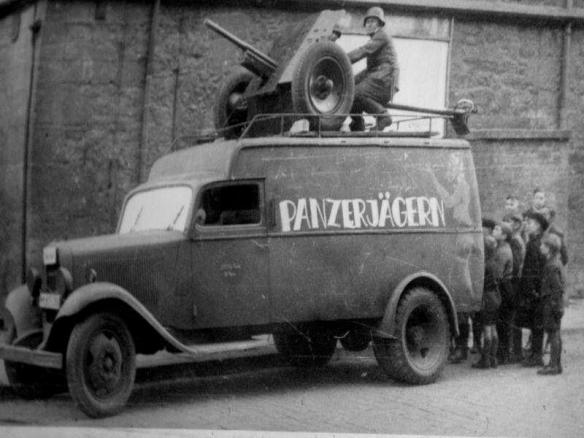
The ideas about motorized warfare that came to be called Blitzkrieg energed in the Reichswehr long before Germany had the tanks and other motorized equipment needed. Here we see what the Reichweht had to work with before the NAZI rearmament program began to take hold. Panzerjägern meant literally Panzer hunter, The photograph is undated, but was probably taken about 1930. This is notable. Even at this early stage the Germans were thinking about tank killers, The English and French who actually had tanks at the time were giving much less attention to anti-tank weapons. Many early German victories were based on either fighting countries without important tank forces or destroying the tanks of the countries that had them. The truck here could have been American. Both Ford and GM had substantial operations in Germany.
Frankfurt, Maneuver Reichswehr
HEINKEL He 60: This sturdy little seaplane was designed to meet a requirement for a shipboard reconnaissance aircraft. This aircraft was built by Heinkel but production was also performed by Arado and Weser. Six He 60E were sent to Nationalist Spain. Various version served with Kü.Fl.Gr and SAGr. units until late 1943.
The German military thought between the world wars revolved almost entirely around the problem of restoring operational freedom and, with it, the kind of war they favored and in which they were supposed to excel. The ideal of the Kesselschlacht remained unaltered; the question was how to gain the freedom of movement necessary for carrying it out. The conventional solution, repeatedly advocated by Chief of Staff Hans von Seeckt during the early twenties, was to rely on highly trained infantry forces employing 1918-style infiltration tactics on a larger scale while taking advantage of every kind of modern weapon, including the air force. This was never very convincing, and during the thirties a group of younger officers began to look at “fast forces” (schnelle Truppen) as the solution to restoring mobility and thus allowing maneuvers aimed at the enemy’s flank and rear. The debate had by no means been resolved when war broke out in 1939. Some five-sixths of the Wehrmacht’s entire order of battle still consisted of infantry divisions; and there were many military leaders, beginning with Gen Ludwig Beck, the chief of the Army General Staff (resigned March 1938), who doubted whether it could be done at all.
During this period, the Germans, with the significant exception of Gen Erich von Ludendorff of World War I fame, also continued to regard war primarily’ as a question of one armed force fighting another. Along with everybody else, they tended to exaggerate the extent of the damage that strategic bombardment could inflict; war games conducted by the Army General Staff during the mid-1930s proceeded on the assumption that within a few days of the beginning of hostilities, a dozen or so German border towns would be in flames. However, with some exceptions, they did not accept the theories of Gen Giulio Douhet, Alexander de Seversky, and others. Douhet had sought to shift the focus of hostilities away from the armed forces; instead of devising better ways in which they could fight and defeat each other, he hoped to make their struggle unnecessary by going after the civilian population instead. His approach did not commend itself to the Germans both because they claimed to have the best armed forces of all and because they believed, correctly as it turned out, that strategic bombardment, even if ultimately successful, would require a long-term massive effort that they could ill afford. Instead, their work during the entire period was aimed at finding better ways in which air power might assist the ground forces and thus help them achieve an operational victory.
When Hitler began rebuilding the Luftwaffe during the mid-1930s, these ideas were reflected in its first operations manual (1935). Entitled Die Luftkriegfuehrung-literally, “The Conduct of Air Warfare”-the manual was signed by the first chief of staff of the Luftwaffe, Gen Walther Wever. It opened by reasserting the traditional German belief that the enemy’s center of gravity lay in his armed forces and that those forces could only be defeated by the combined action of all three services. The first mission of the Luftwaffe, overriding all others, was to gain air superiority either by attacks on the enemy airfields or by air-to-air combat. Next, the manual cut across our current distinctions between the tactical and the strategic; instead, it put the emphasis on the operativ by which Wever, using standard German terminology, meant the maneuvers of large units from division to army group size. Air power was to contribute to victory by attacking military objectives that were quite broadly defined. On the other hand, attacks having as their sole objective the terrorization of the enemy civilian population were explicitly forbidden as being both counterproductive and contrary to the law of war.
The Luftwaffe’s operations in support of the land forces were divided into unmittelbar (“direct”) and mittelbar (“indirect”). Unmittelbare Unterstuetzung, literally “direct support,” which Wever and a majority of officers considered to be of lesser importance, stood for what we today would call direct battlefield support. Besides reconnaissance and artillery observation, it included both bombing and strafing. Mittelbare Unterstuetzung carried connotations of maneuver, leverage, and choke points. It stood for operational warfare behind the front, including strikes at lines of communications, supply bases, and reserves as well as missions against “the sources of the enemy’s strength” (Kraftquellen) such as armament factories; however, as already explained, it excluded the bombardment of the civilian population. All this was very much in line with Clausewitz, Moltke, Schlieffen, and even the rather less well-developed ideas of Seeckt. On the other hand, it rejected both those who envisaged modern war as a “total” struggle of attrition between entire social systems and the more rabid advocates of strategic air power who hoped that aircraft would be able to win wars all on their own.